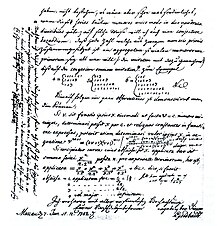Goldbach's weak conjecture
In number theory, the weak Goldbach conjecture is a theorem that states that:
|
(The same prime number can be used more than once in this addition.)
Proved by Harald Helfgott, this conjecture is called "weak" because Goldbach's strong conjecture about the sum of two prime numbers, if proved, would automatically prove Goldbach's weak conjecture. This is so because if every even number greater than 4 is the sum of two odd primes, three can be added to the even numbers greater than 4 to produce the odd numbers greater than 7.
Some express the conjecture as:
|
History
This conjecture dates from 1742. This conjecture says that every natural number greater than 7 is the sum of three prime numbers. It appears in a letter from Goldbach to Euler in 1742. It appeared published without proof in 1770, in Great Britain, in the Meditationes algebraicae, by Edward Waring (1734-1793), who had been senior wrangler at the University of Cambridge in 1757 and Lucasian Professor at the aforementioned university since 1760. The Meditationes algebraicae contain yet another complementary conjecture that states that every odd integer is either a prime or a sum of three primes. This is the so-called weak conjecture.
In 1923, Hardy and Littlewood showed that, assuming some generalization of the Riemann Hypothesis, Goldbach's Weak Conjecture is true for all sufficiently large odd numbers. In 1937, the Russian mathematician Ivan Matveyevich Vinogradov was able to remove the dependency on the Riemann hypothesis and directly proved that all sufficiently large odd numbers can be written as the sum of three primes. Chen Jing-run proved that every sufficiently large number is the sum of a prime with a number that has no more than two prime divisors.
Although Vinográdov was unable to determine what "sufficiently large" meant precisely, his pupil K. Borozdkin proved that ee16,038≈ ≈ 3315{displaystyle mathrm {e} ^{mathrm {e} ^{16{,038}}}}{3^{3^{15}}}}} It is a top quote for the concept of "sufficiently large". This number has more than six million digits, so checking the guess in every number below this quote would be impossible. Fortunately, in 1989 Wang and Chen reduced this to 1043,000. This means if each of the odd numbers is less than 1043,000 It turns out to be the sum of three prime numbers, then Goldbach's weak conjecture will be demonstrated. However, it should still be reduced quite a bit before each number can be checked below it.
In 1997, Deshouillers, Effinger, Te Riele, and Zinoviev showed that the generalized Riemann hypothesis implies the weak Goldbach conjecture. This result combines a general statement valid for numbers greater than 1020 with a thorough computerized search for small cases.
Olivier Ramaré showed in 1995 that every even number greater than four (n≥4) is in fact the sum of at most six primes, from which it follows that every odd number n ≥ 5 is the sum of at most seven primes. Leszek Kaniecki showed that every odd integer is the sum of at most five primes, under the condition of the Riemann hypothesis. In 2012, Terence Tao proved this without the need for the Riemann hypothesis; this improves both results.
Demo
Two papers published in 2012 and 2013 by the Peruvian mathematician Harald Helfgott, which claim to improve the estimates of the major and minor arcs, are considered sufficient to unconditionally prove Goldbach's weak conjecture. From this In this way, the conjecture is proven after 271 years. So, said conjecture becomes a theorem or, in other words, a statement that is deducible from the corresponding axioms, using rules of inference. His work still is under review by other experts.
Contenido relacionado
Scientific notation
Imre lakatos
Square free integer

